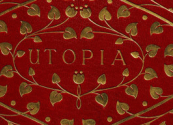Millennium Hall Questions
by Elissa Myers
- The author of the introduction to the Broadview edition of Millennium Hall suggests that the narrative represents a feminization of gentry capitalism. However, this characterization ignores the extent to which the ladies’ religion influences the way they run their “business,” whose expanding operations are always ones of charity. On the other hand, the ladies engage in some shady labor practices, i.e. using child labor and the labor of the aged and disabled frequently, who don’t own their own labor and sometimes even labor for free. The ladies justify this by spreading money around in the way they see fit. How do the ladies’ Christian principles structure the acts of charity they perform? How are these principles used to justify their maternalistic (?) attitudes toward those whom they aid and in the process, rationalize class divisions and labor exploitation in a way that is problematic?
- The structure of Millennium Hall is puzzling to me. How do the frequent interruptions function in the narrative structure? Why are we presented with so many stories, and how do the descriptions of the women’s community (as well as the other communities, homes of villagers, and industries that are the fruits of their organizational labor) fit with the narratives of the women’s individual stories? What purpose do the two frame stories (the narrator and Lamont’s visit and the narrator’s letter home) serve?
- Friendship between women seems to be the heart of both the ladies’ utopian community and their personal stories. Common strands that appear in many of the narratives are the importance of friendship with women of the same age, of good mothering or mentorship by older women (and vice versa, the disastrous effects of bad mothering).These friendships are founded on the ladies’ common Christianity, and sometimes even initiated because of a desire to evangelize. The women help each other resist temptation, teach each other to love virtue instead of vice, and revel in their common love of God. In what ways do you see the Christian nature of the ladies’ friendship having a liberating effect on them? How does it help them to negotiate difficult social situations and moral dilemmas? In what ways does it tinge the ladies’ friendships (and self-concepts) with hints of queerness or auto-eroticism.
- Men are a disruptive, and often an outright evil force in Sarah Scott’s narrative. The young women’s narratives are rife with attempted seduction, and emotional (and implied sexual) abuse. The only harmless relationships between men and women are abortive ones, which nevertheless cause intense emotional pain. However, the novel seems markedly progressive in its ability to even acknowledge men’s culpability in the rape culture that is the eighteenth-century seduction narrative. How is Sarah Scott using these narratives of sexual violence and pain in love to reinforce her rhetorical point about the preferability of female friendship as a relation that soothes one’s emotional pain by facilitating and even mediating one’s connection to God? Does she ever seem to create a male character who does not exist for a primarily rhetorical purpose, but as a fully-rounded character?
- Expanding the common idea of female education seems to be an incredibly important aim of Scott’s narrative. Scott gives much attention to the ladies’ formative years, and to describing the modes by which they were taught intellectually, as well as the moral lessons they learned through experience. How do the ladies’ educations differ from what many women would have received in the eighteenth century? How do we see Scott militating against the adverse effects of the “accomplishment”-based education many women received? How does female friendship reinforce the moral and practical education Scott seems to advocate for women?
- Sarah Scott’s novel is full of overt deus-ex-machinas, and seemingly unlikely plot twists (the reappearance of long-lost mothers, the convenient death of Mr. Hintman, the child molester, etc.) Though devices such as this were common in eighteenth-century romances, Scott asserts that they are not caused by chance, but by the intervention of God. How are these devices used to reinforce Scott’s idea about the superior morality of female friendship? How does she use such devices to dramatize the incredibly difficult moral choices women were often forced to make in the eighteenth century?


